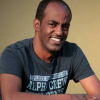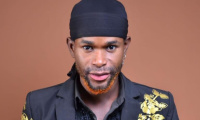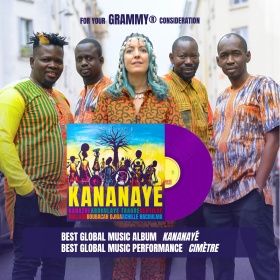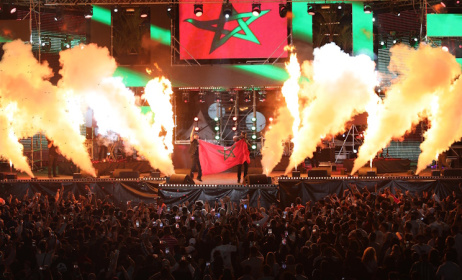The live music scene in Eritrea
This text provides an overview of the live music scene in Eritrea.
 Revelers at a music concert in Eritrea.
Revelers at a music concert in Eritrea.
Origins
Modern Eritrean music has been influenced by the establishment of the American army's Kagnew radio station, which started broadcasting in the 1940s. It was later modernized when local bands emerged in the early 1960s.
Another major contributor to the development of Eritrean music was the establishment of Mahber Theatre Asmara[i] (Asmara Theatre Association) in 1961. Many of today’s legends in Eritrean music emerged during this era, notable for its tense political climate. Bands affiliated to the Eritrean Theatre Association and Mahber Dekebat (Association of the Indigenous) formed at this time and set the standard for future generations.
Today, half a century later, the live music scene in Eritrea has been revitalized with the emergence of new trends, including the so-called 'piano bar' culture that sees many of the old jazz and blues classics revisited.
Piano bar culture
The music scene in the capital of Asmara has traditionally been known for setting the standard of Tigrinya music for listeners in Eritrea and Ethiopia. The relatively recent 'piano bar' phenomenon has been largely exclusive to Asmara because almost all contemporary musicians and singers live in the capital city.
The piano bar culture became popular in Asmara around 2004, when leading singers like Dawit Shilan played at the Ha.Ko.Se.E cafe. At the time - live music in bars being a new experience in the city - the cafe was overcrowded over weekends and many customers had to be turned away.
One of the intrinsic characteristics of the piano bars is that the artists remix a range of classic hits, instead of sticking to performing only their own songs. For example, Dawit Shilan playing Atewebrhan Segid’s 1970s jazz not only brought these classic song back to life, but showed his mastery of performance skills, particularly on the krar.
Piano bars have thus been providing a platform for avant garde jazz and blues artists - and to a lesser extent the local dance music known as Guayla. The sentimental aura in piano bars is accentuated by nostalgic lyrics from the 1960s to the 2000s, which reflect heartbreak, separation, loss and nationalism. Piano bars are sites of true passion and reflection for artists, as they are not bound by the typical demands for upbeat music for dancing.
After the success of gigs at the Ha.Ko.Se.E piano bar, other hotels and cafes were quick to catch on the business. Hotels such as Sunshine, Savana, Bologna cub and Ayele family have been hosting contemporary favourites like Yohannes Tikabo, Tesfay Mengesha and Kahsai Haile regularly.
In 2013, the Berhe Aiba Hotel started a new type of live performance by giving prominence to musicians rather than singers. Jazz classics were played, with singers such as Yohannes Tikabo only featuring on certain tracks. Some of the best talents in Eritrean music - like Shonqie, Fanjai, Chobie and Gidewon - were brought together as a band to provide a unique experience for discerning fans. The place became a hangout for many musicians, many of whom would get on stage and start playing. Today Berhe Aiba hotel is regarded as one of the clubs in Asmara.
The success of piano bars in Asmara could have a lot to do with the Gaeda genre, which is played in Swa houses in Aba Shawel, a district of Asmara that has traditionally been home to many highly acclaimed artists across generations. Gaeda is a communal music experience where a singer plays songs accompanied by friends beating drums, clapping and singing along. Many of these songs are exclusively played in Gaeda settings and are never recorded or released on albums. Songs are often modified by whoever sings them, adding thought-provoking social and political mesages.
Venues
The main live music venues in the capital are located at the Asmara Expo grounds[ii], not far from Asmara International Airport. Within the expo grounds are numerous restaurants, bars and concert halls. There are regular live concerts on the weekends at venues such as Shamrock Cafe, Hidmo, West End and Expo Hall. The dominant type of music played in these establishments is Guayla, the upbeat dance music of Tigrinya culture that has been dominant as a contemporary genre. Unlike the piano bars and their Gaeda music, audiences at these concerts are more intent in dancing the night away, rather than simply sitting back and appreciating the music. The expo grounds also host the annual national festival.
Music fans in Eritrea also frequent the international concerts hosted at Cinema Roma in Asmara, where African stars such as Tiken Jah Fakoly, Fatoumata and Habib Koite have given widely acclaimed concerts, typically supported by the Alliance Francaise d'Asmara.
The biggest concerts and shows in the nation happen during national holidays, mainly organized by the Cultural Bureau of the ruling People's Front for Democracy and Justice (PFDJ) party. The biggest of these shows takes place every year over more than a week to mark the national Independence Day on 24 May. The celebrations see music performances at various venues, including Bahti Meskerm Square, Cinema Roma and Cinema Odeon, with the main event held at the National Stadium on Independence Day attended by the president and various diplomats. Although most of the songs produced during the state-organized concerts are patriotic in nature, a few love songs are also commissioned as new releases.
Similar events are also organized in other towns in Eritrea during the national holidays, mainly in town stadiums and halls. The main ones are those held in Massawa, Dekemhare and Keren. In February, Massawa city hosts the Fenkil, commemorating the liberation of the coastal city in 1990, where a series of performances and patriotic songs are showcased. Sawa, the military training centre in the Western lowlands of Eritrea, also hosts many annual concerts that are often televised or broadcast online. The shows in Sawa are coordinated for the tens of thousands of high school students who must spend a year in the barracks. The biggest shows are organised during the graduation of trainees, along with the National Youth Festival (known as Eri-Youth) that is organized every two years in Sawa. The sixth edition of the festival was held in July 2014. [iii]
Festivals
Hosted annually around August, the Eritrean National Festival is the biggest cultural event of the year. A multitude of exhibitions, shows and performances are staged by artists and cultural troupes from throughout the country. Throughout the 10-day festival, which usually commences at the beginning of August or late July, open-air night concerts are held by both professional and amateur acts, many of which represent the country's various army divisions, who compete every year for an award.
The greatest attraction at the festival is the series of colorful traditional cultural shows representing the diverse ethnicities of the country. Various styles of costume, music and dance are brought together in nearby settings, creating a mosaic of noise and color. The festival climaxes on the final night, when outstanding traditional performances and songs are given the annual Raimoc Award. Elias Weldegebriel (2013), a prominent music instructor in Asmara, notes that the competing performances are not all authentic, traditional representations as they are often “modified for the sake of uniformity, choreography and the need for spectacle.”
Challenges
One of the greatest shortcomings of contemporary Eritrean live music is artists' over-reliance on playbacks, so that singers are often reduced to merely being actors. Many of the concerts performed publicly on the above holidays follow this trend, which nurtures mediocrity while restricting competitiveness and vocal excellence. This persistent problem has to a certain degree paralyzed live music in Eritrea, as the relevance of bands with a full line-up of instruments has dwindled. This has led to the production of music in studios where instrumental tracks are recorded separately, often without the musicians ever even coming together. A singer who records the vocals a few days before the scheduled concerts then faces the unenviable task of lip-syncing the new song at the most important concert of the year.
References
Weldegebriel, Elias. 2013. 'Community Music in Africa: Perspectives.' Community Music Today. p.61.
[i] www.qienit.com/mata-asmara-theater-association/ [ii] www.asmera.nl/asmara-expo.htm [iii] http://allafrica.com/stories/201407210045.html























Commentaires
s'identifier or register to post comments